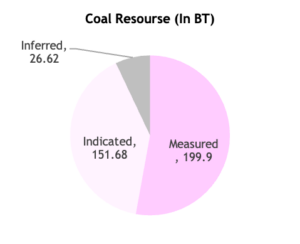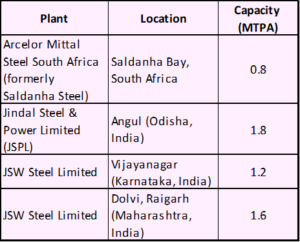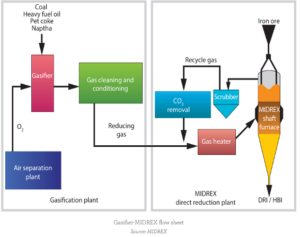Surface Coal Gasification in India: Opportunities and Strategic Relevance
As per the National Coal Inventory 2023, India holds coal reserves of 378.21 billion tonnes as of April 1, 2023. Currently, around 80% of the coal produced is consumed by thermal power plants. With the global shift — including in India — towards cleaner energy sources in response to climate change, finding a sustainable way to utilize these vast coal reserves would be highly beneficial for the country.
 Coal gasification is considered as one of the promising cleaner option compared to burning of coal.
The National Steel Policy envisions achieving 300 MT of production capacity by 2030-31 and 500 MT by 2047. To support this growth and associated production processes, the estimated coal requirement will be around 300 MTPA — comprising approximately 165 million tonnes of coking coal, 35 MTPA of pulverized coal injection (PCI) coal, and 100 million tonnes of non-coking coal for direct reduced iron (DRI).
Coal gasification is considered as one of the promising cleaner option compared to burning of coal.
The National Steel Policy envisions achieving 300 MT of production capacity by 2030-31 and 500 MT by 2047. To support this growth and associated production processes, the estimated coal requirement will be around 300 MTPA — comprising approximately 165 million tonnes of coking coal, 35 MTPA of pulverized coal injection (PCI) coal, and 100 million tonnes of non-coking coal for direct reduced iron (DRI).
Coke remains a critical input in steel making, with around 0.9 tonnes of coke required to produce 1 tonne of hot metal (HM) via BF-BOF. However, Indian coking coal is generally having higher ash content. Therefore, major Steel makers relied upon Imported coking coal.
To curtail this, Synthesis gas (Syngas), primarily comprising carbon monoxide (CO) and hydrogen (H₂), serves as an effective and environmentally friendly reducing agent in steelmaking via the gas-based DRI route. Companies like JSPL have already established steel production facilities using gas-based DRI technology. Promoting the establishment of such plantsis strongly recommended to reduce India’s dependence on imported coking coal, in alignment with the objectives of the Atmanirbhar Bharat AbhiyaanA flagship initiative in this direction, National Coal Gasification Mission, which aims to achieve 100 MT of gasification by 2030 with an investment of ₹8,500 crore has been initiated by Ministry of Coal. This initiative promotes the use of high-ash, non-coking domestic coal to generate synthesis gas (syngas), a cleaner alternative for DRI (Direct Reduced Iron) steelmaking.
Key Policy Initiatives for Coal Gasification
Coal gasification is considered as one of the promising cleaner option compared to burning of coal. The National Steel Policy envisions achieving 300 MT of production capacity by 2030-31 and 500 MT by 2047. To support this growth and associated production processes, the estimated coal requirement will be around 300 MTPA — comprising approximately 165 million tonnes of coking coal, 35 MTPA of pulverized coal injection (PCI) coal, and 100 million tonnes of non-coking coal for direct reduced iron (DRI). Coke remains a critical input in steel making, with around 0.9 tonnes of coke required to produce 1 tonne of hot metal (HM) via BF-BOF. However, Indian coking coal is generally having higher ash content. Therefore, major Steel makers relied upon Imported coking coal.Coal Gasification: Way Forward
To meet the ambitious target of net zero emission by 2070, coal needs to be used sustainably by leveraging clean coal technologies like gasification, carbon capture technologies.
Proven gasification technologies in several countries, use low ash coal (up to 25%), whereas 74% of Indian coal has ash content of more than 40%. Moving bed and Fluidized Bed technology (FBT) technology that can handle high ash coal (non washed coal) & converts Carbon containing material into Synthesis gas, composed primarily of Carbon monoxide and Hydrogen.
Cold syngas is depressurized to 3 kg/cm², and for high flow rates, a turbo-generator recovers energy during depressurization. The low-pressure syngas is blended with recycled top gas to form a reducing gas, heated to 900°C, and introduced into the shaft furnace for iron oxide reduction.
Key reactions:
Fe₂O₃ + 3H₂ → 2Fe + 3H₂O Fe₂O₃ + 3CO → 2Fe + 3CO₂
The spent gas is cleaned and CO₂ content is reduced below 5% to maintain a high (H₂ + CO) to (H₂O + CO₂) ratio (>10) for efficient reduction. The H₂/CO ratio is optimized at 1.6. DRI exits the furnace at around 700°C, and the treated gas is recycled.
The system accommodates diverse fuels — bituminous coal, sub-bituminous coal, lignite, petcoke, and refinery residues. Given India’s high- ash coal (e.g., Lurgi) and fluidized bed gasifiers are the most suitable for Indian Coal.
Direct Reduction of Iron Production (DRI) Using Coal Gasification
Conclusion and Suggested Key Initiatives by the Govt. to make Coal Gasification a Success
India, the world’s second-largest steel producer, relies heavily on the Direct Reduced Iron (DRI) sector, which contributes around 39.3% of global DRI output. However, DRI plants in India currently operate at a modest 60% capacity utilization. With the steel sector poised for strong growth, the DRI route is expected to remain a critical component. To meet future demands sustainably, it is essential for DRI plants to enhance both energy efficiency and environmental performance. Alongside upgrading existing technologies, new DRI projects must prioritize the adoption of low-carbon pathways. Presently, coal gasification and natural gas reforming are commercially viable options & being actively explored worldwide. Key Initiatives may be adopted for for Coal Gasification: Financial Incentives: Provide Viability Gap Funding and tax exemptions on coal feedstock. Incentivize private sector participation to boost investment.Infrastructure Development:
Allocate dedicated coal mines for gasification projects.
Strengthen coal transportation networks Policy Frameworks: Frame policies for efficient use of gasification by-products. Focus on R&D for advanced gasification technologies. Other Initiatives: Encourage localization to lower technology costs and build self-reliance.





